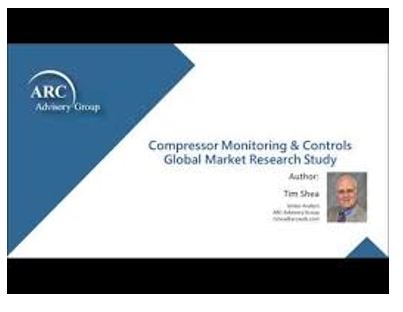

ARC recently completed an update to its compressor monitoring & controls market study. Lead author, Tim Shea, was interviewed by Allen Avery on some of the key highlights uncovered during the research process that users and suppliers of compressor monitoring & controls may find of interest.
Allen: Hello, and welcome
Tim: Thanks, Allen. I've been covering compression monitoring and controls market at ARC since 2015, and I've been researching on and off the larger control systems market for over 20 years. The main system types that we're concerned about in compressor monitoring & controls are the axial and centrifugal compressors, both rotatory dynamic types and reciprocating and rotary compressor types, both positive displacement types.
Allen: What trends are driving customers to increase their investment in compressor monitoring and controls?
Tim: The three main trends driving investment in compression monitoring & controls are: one, the need for greater efficiency. Compressor monitoring and control solutions are seen as enabling users to reduce energy consumption of the compressor itself. And, in most cases, the energy of any associated processes for which the compressor is being utilized.
Two, there is the increased demand for energy and the growing demand for natural gas for power generation. Global demand for energy consumption is forecast to rise between 1.5 to 2% annually over the next 20 years, and the primary drivers of that are countries like China and India with their developing economies.
Natural gas is seen as the bridge fuel for power generation, until we reach solar power dominance well beyond 2050. We expect this demand for natural gas to capture greater share of the energy mix, and therefore there will be an increased need for compression of that gas.
Finally, many legacy compressor control systems will require upgrades themselves to extend the life of the compressor. Over time, the need to upgrade legacy compressor control systems with enhanced functionality and performance capability will spur more companies to realize the benefits of upgrading these solutions. We believe that word of mouth success stories will spur a greater demand for the new technologies, including smart sensors, advanced analytics, and machine learning.
Allen: Now, I wonder what are some of the underlying drivers that have been critical to growth in the compressor monitoring & controls market?
Tim: The main underlying drivers that have been critical to growth in this market are: number one, the increasing economic growth globally. As developing countries grow their economies and more people demand products derived from manufacturing processes that rely on compression, the need for monitoring control of those compressors will obviously grow as well. Two, the increasing functionality and performance of the monitoring and control systems themselves. As suppliers continue to improve upon their monitoring and control solutions, the benefits of compressor optimization, process improvements, including reduced unplanned downtime, and compressor uptime and extended operational life are all factors driving greater demand and adoption.
Third, the influence of the industrial Internet of Things. The emergence of IIOT and its potential promise of leveraging smart sensors to create smart compressors that can be monitored remotely, measured and controlled more efficiently, and/or reduce costs will no doubt play an important role in increasing the adoption of compressor monitoring and control solutions given the potential benefits that could be realized with their adoption.
Allen: Makes sense to me. What are some of the key strategic initiatives for suppliers to consider in order to improve their position in the compressor monitoring & controls market?
Tim: The key strategic initiatives we recommend to suppliers to improve their competitive position are: one, to continue to invest in targeted product development that may be focusing on optimizing low capacity, extending the surge line, and any other key operational requirements that will benefit the customer. In conjunction with that, educate the users on these benefits and providing any meaningful metrics that can be quantified operationally through user success stories should go a long way towards getting customers to be more receptive in adopting the new technologies.
Second, suppliers should work closely with these end users to better understand their current and changing operational requirements, which will help further develop and target the supplier’s product development efforts. And, we also recommend offering as a complete portfolio of system types as possible. That means, if appropriate, offer axial centrifugal, reciprocating and rotary monitoring and control system types, if possible.
The advent of smart compressors is going to open the doors to potentially new business models. Suppliers can now become providers of say, compressed air as a service, or natural gas compression services to help customers reduce their costs and streamline their operations. Many are already offering remote monitoring and control services to their customers to help them in this era of “the Great Crew change” with fewer resources to be leveraged – basically having to do more with less.
Lastly, the emergence of the industrial IoT and the advent of these new technologies has spurred the growing need for suppliers to develop a complete IIoT ecosystem. ARC believes that no one supplier yet can do it all. Therefore, it's critical developing strategic partnerships with other suppliers of different technologies in order to provide a comprehensive IIoT-enabled compressor monitoring & controls solutions package.
Allen: Thanks for all your insights, Tim. That about does it for us in the ARC automation studio and our discussion of the compressor monitoring and controls market. Anybody in the audience who would like more information should get in touch with a client manager here at ARC, or the author directly at tshea@arcweb.com . The video/audio of this discussion is available at Compressor Monitoring & Controls Market.
Thanks for your attention and have a great day.

